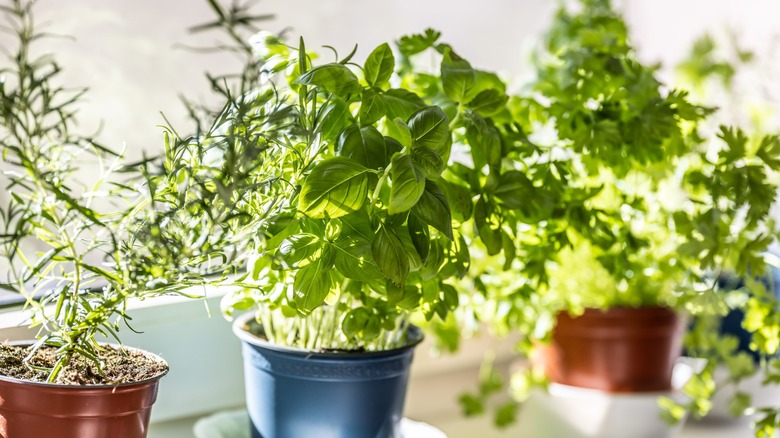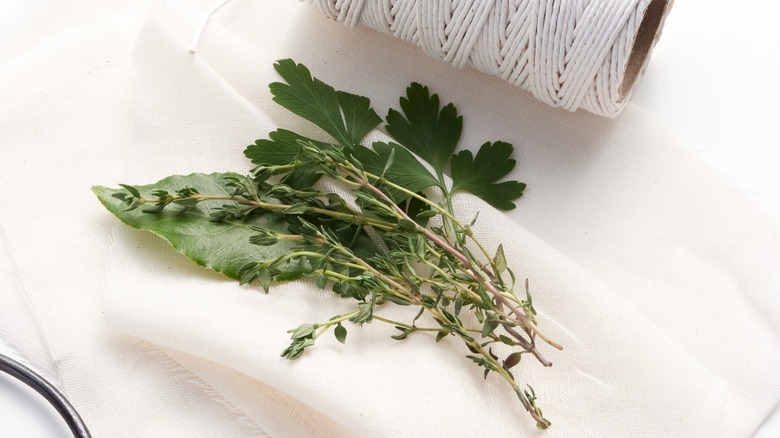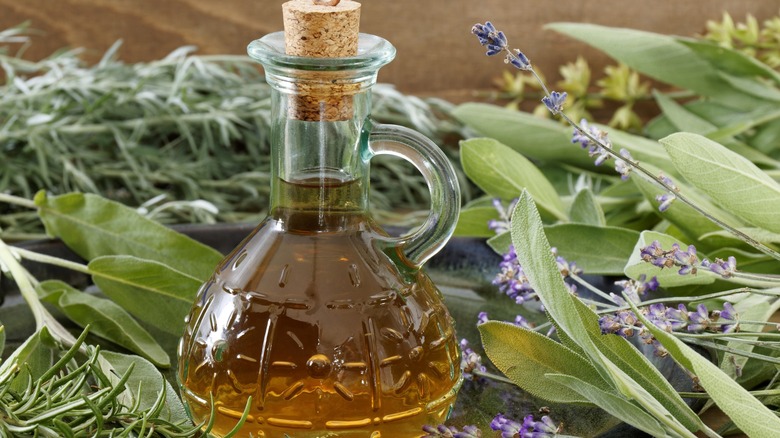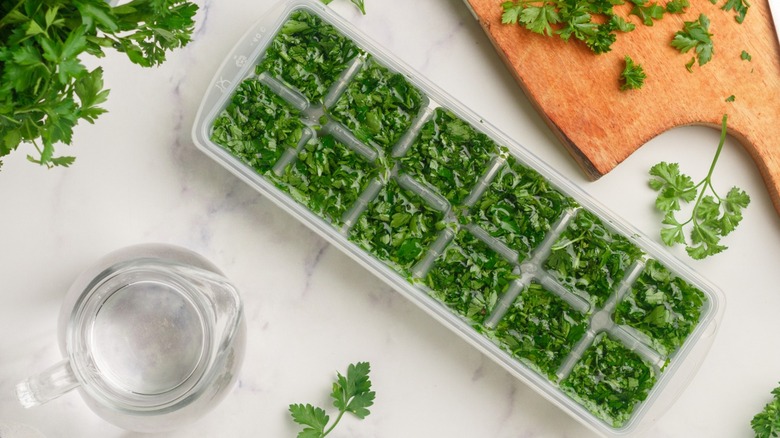How To Use Up Leftover Herb Stems Like A Pro
Often, only the leafy parts of herbs get the attention they deserve, while the stems get left behind — sad, forgotten, and eventually discarded. Yet, these stems don't deserve to be cast aside as kitchen waste. While they may not have the same tender texture or visual appeal as the leaves, herb stems can still contribute an incredible depth of flavor to a variety of dishes. Regardless of the type, whether soft or hard and woody, these stems can enhance your cooking with an extra layer of flavor that would otherwise be lost. Instead of discarding them, they can enhance your dishes if you how to use them.
Soft herbs, such as parsley, cilantro, basil, dill, oregano, and mint, have pliable stems that share nearly the same flavor profile as their leaves, though sometimes they can be slightly more bitter. While the stems may be a bit crunchier and less appealing for garnishing, they are still great for adding flavor into cooked dishes without much noticeable difference in taste. On the other hand, woody herbs like rosemary, thyme, and oregano have tough, fibrous stems that don't break down well and aren't suitable for eating directly. Yet they can still work like magic to impart flavors to your soups, broths, and oils, especially in slow-cooked dishes during simmering. This allows them to release their herbaceous, aromatic flavors without leaving behind their tough, unappealing texture.
Flavor up your soups
Both woody and soft herb stems are wonderful for adding extra flavor to soups, stocks, and broths. Simply toss them into the pot as it simmers, allowing the stems to gently infuse your dish with richer taste. Whether you're making a simple homemade vegetable or chicken stock, a rich Parmesan broth, or any deliciously filling hearty stews, herb stems act as natural flavor boosters, and since they're discarded at the end, their appearance is nothing to worry about.
A great way to use herb stems is by adding them to a bouquet garni, which traditionally includes parsley, thyme, and a bay leaf. You can wrap the herbs together using the outer leaves of a leek or tie them into a bundle with kitchen twine. Alternatively, if you have kitchen sachet bags, you can easily place your herb stems inside, allowing them to be easily removed at the end of cooking.
Herbaceous infusions
Both soft and woody herb stems can be infused into flavorful oils, vinegars, or syrups to add a robust and fun twist to your everyday condiments. For oils, woody stems work particularly well, with their lower moisture content. There are two methods to infuse an oil. One involves boiling the stems in olive or neutral oil along with your choice of aromatics, like dried chilis or garlic, then remove from heat and leave the mixture to steep. Alternatively, you can simply warm the oil and leave the stems to steep overnight. For infused vinegars, heat red or white wine vinegar and steep your herb stems overnight after ensuring they're clean and dry. These infusions can be used in salads, marinades, or as finishing oils to boost flavor.
You can also make a simple syrup with herb stems by simmering them with equal parts water and a sweetener like agave, honey, or sugar. Add some extra aromatics like ginger, for a punch of flavor, and a little lemon juice for some added sharpness. Once cooled, strain the syrup and use it to sweeten anything from tea, coffee, to juices and smoothies. Basil, mint, thyme, and sage stems are ideal for adding a comforting, herbal aroma to your favorite morning beverage.
Sauces, dressings, and flavor boosters
Soft herb stems are incredibly versatile and can seamlessly elevate various dishes, sauces, and dressings with just a quick chop, without anyone realizing they're even there. You can toss chopped tender stems into salads, or use them to add flavor to rice. You can also finely chop them and mix them into frittatas, burger patties, or dips like tzatziki and guacamole. Try a spicy jalapeño pesto using basil stems, or blend parsley, cilantro, and oregano stems into your next chimichurri sauce to pair perfectly with steak. Even easier, simply throw stems into marinades to infuse meats with flavor — no chopping required!
While hard herb stems aren't palatable like soft herbs, they pack a punch with deep, aromatic flavors. Their slight bitterness and dry texture make them perfect for grills and roasts, which can add a rich, smoky depth to your dishes. Next time you fire up the grill, try placing woody herb stems directly on the coals to infuse your meat with a delightful herbaceous smokiness for an unforgettable BBQ bite. Additionally, thick stems like rosemary and thyme can double as natural skewers, imparting even more flavor as you grill your meat.
Ways to preserve your herb stems
Looking to save your herb stems for their next culinary comeback? There are several simple methods, and when stored properly, they can last for 6-9 months and can offer a flavorful boost to your future dishes at any time. The easiest method is to chop the stems, either by hand or using a food processor, and freeze them in a ziplock bag without any additives. To help preserve the vibrant flavor of your herb stems, blanch them before chopping and freezing them. They'll make a great addition to any of your salads.
Alternatively, you can place the chopped stems in an ice cube tray, cover them with water or olive oil (or any other convenient vegetable oil), and freeze them. To preserve the vibrant color of your herb stems, blanch them before chopping and freezing them. Once the cubes are frozen, you can transfer them to a bag for storage. Water-based cubes are perfect for seasoning soups, broths, and stews, while oil-based cubes work well in stir-fried dishes. You'll be amazed at how beautiful they look and the depth of flavor they bring to your dishes!




